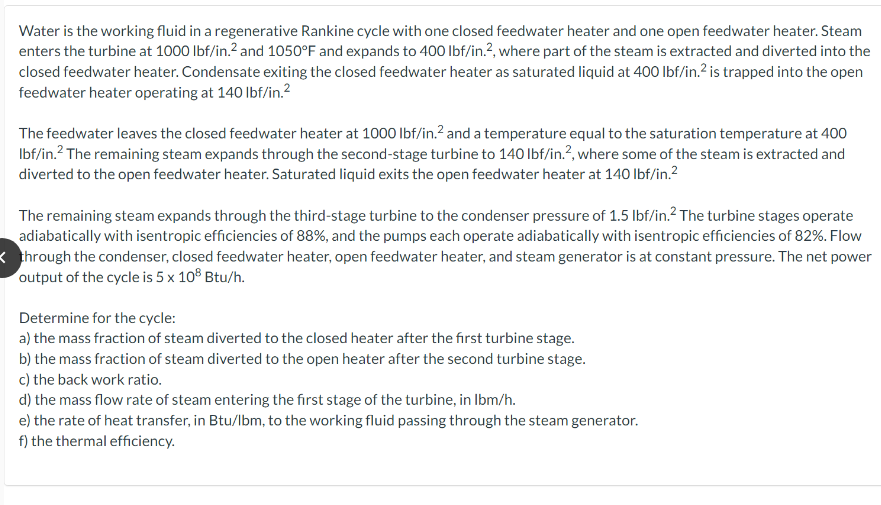Water is the working fluid in a regenerative Rankine cycle with one closed feedwater heater and one open feedwater heater. Steam enters the turbine at 1000 lbf/in.² and 1050°F and expands to 400 lbf/in.2, where part of the steam is extracted and diverted into the closed feedwater heater. Condensate exiting the closed feedwater heater as saturated liquid at 400 lbf/in.² is trapped into the open feedwater heater operating at 140 lbf/in.² The feedwater leaves the closed feedwater heater at 1000 lbf/in.² and a temperature equal to the saturation temperature at 400 lbf/in.² The remaining steam expands through the second-stage turbine to 140 lbf/in.2, where some of the steam is extracted and diverted to the open feedwater heater. Saturated liquid exits the open feedwater heater at 140 lbf/in.² The remaining steam expands through the third-stage turbine to the condenser pressure of 1.5 lbf/in.² The turbine stages operate adiabatically with isentropic efficiencies of 88%, and the pumps each operate adiabatically with isentropic efficiencies of 82%. Flow through the condenser, closed feedwater heater, open feedwater heater, and steam generator is at constant pressure. The net power output of the cycle is 5 x 108 Btu/h. Determine for the cycle: a) the mass fraction of steam diverted to the closed heater after the first turbine stage. b) the mass fraction of steam diverted to the open heater after the second turbine stage. c) the back work ratio. d) the mass flow rate of steam entering the first stage of the turbine, in lbm/h. e) the rate of heat transfer, in Btu/lbm, to the working fluid passing through the steam generator. f) the thermal efficiency.
Water is the working fluid in a regenerative Rankine cycle with one closed feedwater heater and one open feedwater heater. Steam enters the turbine at 1000 lbf/in.² and 1050°F and expands to 400 lbf/in.2, where part of the steam is extracted and diverted into the closed feedwater heater. Condensate exiting the closed feedwater heater as saturated liquid at 400 lbf/in.² is trapped into the open feedwater heater operating at 140 lbf/in.² The feedwater leaves the closed feedwater heater at 1000 lbf/in.² and a temperature equal to the saturation temperature at 400 lbf/in.² The remaining steam expands through the second-stage turbine to 140 lbf/in.2, where some of the steam is extracted and diverted to the open feedwater heater. Saturated liquid exits the open feedwater heater at 140 lbf/in.² The remaining steam expands through the third-stage turbine to the condenser pressure of 1.5 lbf/in.² The turbine stages operate adiabatically with isentropic efficiencies of 88%, and the pumps each operate adiabatically with isentropic efficiencies of 82%. Flow through the condenser, closed feedwater heater, open feedwater heater, and steam generator is at constant pressure. The net power output of the cycle is 5 x 108 Btu/h. Determine for the cycle: a) the mass fraction of steam diverted to the closed heater after the first turbine stage. b) the mass fraction of steam diverted to the open heater after the second turbine stage. c) the back work ratio. d) the mass flow rate of steam entering the first stage of the turbine, in lbm/h. e) the rate of heat transfer, in Btu/lbm, to the working fluid passing through the steam generator. f) the thermal efficiency.
Power System Analysis and Design (MindTap Course List)
6th Edition
ISBN:9781305632134
Author:J. Duncan Glover, Thomas Overbye, Mulukutla S. Sarma
Publisher:J. Duncan Glover, Thomas Overbye, Mulukutla S. Sarma
Chapter6: Power Flows
Section: Chapter Questions
Problem 6.47P
Related questions
Question
15

Transcribed Image Text:Water is the working fluid in a regenerative Rankine cycle with one closed feedwater heater and one open feedwater heater. Steam
enters the turbine at 1000 lbf/in.² and 1050°F and expands to 400 lbf/in.², where part of the steam is extracted and diverted into the
closed feedwater heater. Condensate exiting the closed feedwater heater as saturated liquid at 400 lbf/in.² is trapped into the open
feedwater heater operating at 140 lbf/in.²
The feedwater leaves the closed feedwater heater at 1000 lbf/in.² and a temperature equal to the saturation temperature at 400
lbf/in.² The remaining steam expands through the second-stage turbine to 140 lbf/in.2, where some of the steam is extracted and
diverted to the open feedwater heater. Saturated liquid exits the open feedwater heater at 140 lbf/in.²2
The remaining steam expands through the third-stage turbine to the condenser pressure of 1.5 lbf/in.² The turbine stages operate
adiabatically with isentropic efficiencies of 88%, and the pumps each operate adiabatically with isentropic efficiencies of 82%. Flow
through the condenser, closed feedwater heater, open feedwater heater, and steam generator is at constant pressure. The net power
output of the cycle is 5 x 108 Btu/h.
Determine for the cycle:
a) the mass fraction of steam diverted to the closed heater after the first turbine stage.
b) the mass fraction of steam diverted to the open heater after the second turbine stage.
c) the back work ratio.
d) the mass flow rate of steam entering the first stage of the turbine, in lbm/h.
e) the rate of heat transfer, in Btu/lbm, to the working fluid passing through the steam generator.
f) the thermal efficiency.
Expert Solution
This question has been solved!
Explore an expertly crafted, step-by-step solution for a thorough understanding of key concepts.
Step by step
Solved in 6 steps with 6 images

Knowledge Booster
Learn more about
Need a deep-dive on the concept behind this application? Look no further. Learn more about this topic, electrical-engineering and related others by exploring similar questions and additional content below.Recommended textbooks for you

Power System Analysis and Design (MindTap Course …
Electrical Engineering
ISBN:
9781305632134
Author:
J. Duncan Glover, Thomas Overbye, Mulukutla S. Sarma
Publisher:
Cengage Learning

Power System Analysis and Design (MindTap Course …
Electrical Engineering
ISBN:
9781305632134
Author:
J. Duncan Glover, Thomas Overbye, Mulukutla S. Sarma
Publisher:
Cengage Learning